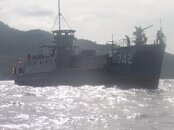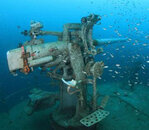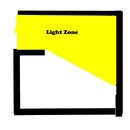currier
Contributor
It has been nearly a month since returning from my latest Thai trip, so I'd now like to take the time to share with you, SB members, a brief report comprised of pleasant memories made with Master Divers on Koh Tao.
Ayesha is an active member here, and it was this site through which I first learned of Master Divers. She answered all of my questions regarding the type of diving I would like to conduct during my stay - PADI Wreck Specialty on the HTMS Sattakut, a 49m landing craft sunk near Hin Pee Wee to a depth of approx. 30m within the past 9 months. I'd visited Tao twice in the past, have dived with other operators, and enjoyed and extensively explored most of the sites that the island offers. This trip would be shorter than previous ones ... also, my time would be shared between the sea and my non-diving fiancée. I had only a few days to dive, so my selection of shop and itinerary required forethought.
 NOT my photo - but from Sea Explorers Club Koh Tao
NOT my photo - but from Sea Explorers Club Koh Tao
Hats off to staff in the shop for their welcome! Specifically Phill, Rachel, and Charlotte, who made me feel right at home DESPITE my late arrival of one day, tardiness that subsequently upset training schedules of instructors. Sorry, guys! Well, we completed the paperwork, Rachel gave me an earful about not having divers insurance (I know, I know!!), and we decided on my starting time. Turns out I would commence the course alone with Martin that afternoon. Super!
I made an attempt to complete the book in an hour and a half - I did, honestly - but I didn't quite make it to the end. No worries, Martin covered all topics in his lesson. We sat at a table in the shop for about three or three and a half hours and went over everything from legal concerns, equipment selection, safety issues, assessment criteria, penetration procedures, rec limits, etc., etc. before concluding for the day. In hindsight I should have borrowed a book for a day or two from my LDS to peruse the reading beforehand, but like I mentioned - Martin was thorough!
The next morning we conducted dive one. I'd been dreaming of a boat like the Sattakut for more than two years - since OW certification! I'm a second generation diver, and it was tales from my father of Great Lakes, St. Lawrence, and Tobermory wrecks and penetrations that motivated me toward this sort of diving rather than, say, photography. I've long awaited my first descent onto a deck, around the perimeter of a hull, into a wheelhouse, or through dark passageways and living quarters.
Dive one was perfect! The viz. was an exceptional 15m, and we explored the entirety of her exterior marking depths, hazards, and points of interest on our slates. The Sattakut is an ideal starter wreck put down at an ideal depth. She has portholes into which to peer, exterior stairwells to climb up and down, a pleasant swim through the tower, and she maintained her bow and stern guns, a must see for anyone down on her.
Dive two later that afternoon was a different story. I recorded 1m viz. in my logbook, but I think this was generous. Our task on this dive was to locate and record on my slate possible entries and exits. Well, I was fortunate that my instructor was experienced with the site since I was more likely to frog kick face first into a stairwell than find a doorway on my own.
Dive three took place the next morning. We were to relocate the possible entries and exits, inspect for places onto which to secure our penetration lines, and run our line along an exterior length entry-exit. Fortunately the scuba gods took favor on us - 15m viz. and not another soul on the site! I truly enjoyed these exercises, and once completed, we explored around a bit until our NDL forced us topside.
Dive four was to be conducted that afternoon. We were to perform two penetrations, the first going from the central wheel house downstairs and up toward the bow, and the second from the wheel house inside through the corridor and out toward the stern.
We exercised a few considerations for this dive ...
1) torches and back-ups
2) EANx32
3) pony bottle.
We descended on her, and encountered the same low viz. as the previous afternoon. One literally had to be on the deck to see it. Martin led us to the first entry, the stairwell that would take us below deck, but I felt a bit anxious to continue. I indicated my concern, and he suggested we complete the upper deck penetration first to see how things went. He led, I followed, and it was over before I knew it. I felt some embarrassment from my initial hesitation, and agreed to follow him back through and retrieve our line for us.
We were left with alotta enriched air, lotsa NDL, and a dark, taunting stairwell. Some things were going through my head at this point ...
1) What else are we going to do down here? We can't see a thing!
2) I paid money to do this!
3) What would my father say?!?
I realized I had nothing to fear save for harboring a regret for years to come, so I indicated to Martin that we should do the second penetration. He made a blasé gesture to the suggestion, but I wanted to make it clear - no, no, I'll be the reel diver this time, let's go!
The descent down the stairs was an eery one - it was nearly dark excepting a bit of dull light from afar. It didn't have the "closed-in" feeling that I had anticipated, on the contrary I felt quite free with enough space in which to move around. The corridor was shorter than the last, and it opened up into a room that enabled divers to venture off to the left slightly (another very small room?). I was laying my line on my left hand side, and I knew not to go that way, but I HAD to take a peek before continuing slightly to the right, straight up, and out.
By this point I was filled with adrenaline, sense of completion, and excitement for the upcoming - since we had to go back down again to retrieve our line. Afterward Martin and I took a look at the wheel house again, then continued to the bow gun where I shot at a few fish before being frightened off for the day by NDL.
 NOT my photo - but from CSI: Samui
NOT my photo - but from CSI: Samui
Our long tail ride back was quieter than expected, but Martin said it all when he told me "That's what makes it all worthwhile - seeing customers smile like that" (or something thereabouts).
In short, this shop and crew truly raise the bar when it comes to hospitality, safety, and all-around professional dive op standards. Well done, Master Divers! The one regret that I took home with me was that I was able to dive with you but a few days ...
Ayesha is an active member here, and it was this site through which I first learned of Master Divers. She answered all of my questions regarding the type of diving I would like to conduct during my stay - PADI Wreck Specialty on the HTMS Sattakut, a 49m landing craft sunk near Hin Pee Wee to a depth of approx. 30m within the past 9 months. I'd visited Tao twice in the past, have dived with other operators, and enjoyed and extensively explored most of the sites that the island offers. This trip would be shorter than previous ones ... also, my time would be shared between the sea and my non-diving fiancée. I had only a few days to dive, so my selection of shop and itinerary required forethought.
 NOT my photo - but from Sea Explorers Club Koh Tao
NOT my photo - but from Sea Explorers Club Koh TaoHats off to staff in the shop for their welcome! Specifically Phill, Rachel, and Charlotte, who made me feel right at home DESPITE my late arrival of one day, tardiness that subsequently upset training schedules of instructors. Sorry, guys! Well, we completed the paperwork, Rachel gave me an earful about not having divers insurance (I know, I know!!), and we decided on my starting time. Turns out I would commence the course alone with Martin that afternoon. Super!
I made an attempt to complete the book in an hour and a half - I did, honestly - but I didn't quite make it to the end. No worries, Martin covered all topics in his lesson. We sat at a table in the shop for about three or three and a half hours and went over everything from legal concerns, equipment selection, safety issues, assessment criteria, penetration procedures, rec limits, etc., etc. before concluding for the day. In hindsight I should have borrowed a book for a day or two from my LDS to peruse the reading beforehand, but like I mentioned - Martin was thorough!
The next morning we conducted dive one. I'd been dreaming of a boat like the Sattakut for more than two years - since OW certification! I'm a second generation diver, and it was tales from my father of Great Lakes, St. Lawrence, and Tobermory wrecks and penetrations that motivated me toward this sort of diving rather than, say, photography. I've long awaited my first descent onto a deck, around the perimeter of a hull, into a wheelhouse, or through dark passageways and living quarters.
Dive one was perfect! The viz. was an exceptional 15m, and we explored the entirety of her exterior marking depths, hazards, and points of interest on our slates. The Sattakut is an ideal starter wreck put down at an ideal depth. She has portholes into which to peer, exterior stairwells to climb up and down, a pleasant swim through the tower, and she maintained her bow and stern guns, a must see for anyone down on her.
Dive two later that afternoon was a different story. I recorded 1m viz. in my logbook, but I think this was generous. Our task on this dive was to locate and record on my slate possible entries and exits. Well, I was fortunate that my instructor was experienced with the site since I was more likely to frog kick face first into a stairwell than find a doorway on my own.
Dive three took place the next morning. We were to relocate the possible entries and exits, inspect for places onto which to secure our penetration lines, and run our line along an exterior length entry-exit. Fortunately the scuba gods took favor on us - 15m viz. and not another soul on the site! I truly enjoyed these exercises, and once completed, we explored around a bit until our NDL forced us topside.
Dive four was to be conducted that afternoon. We were to perform two penetrations, the first going from the central wheel house downstairs and up toward the bow, and the second from the wheel house inside through the corridor and out toward the stern.
We exercised a few considerations for this dive ...
1) torches and back-ups
2) EANx32
3) pony bottle.
We descended on her, and encountered the same low viz. as the previous afternoon. One literally had to be on the deck to see it. Martin led us to the first entry, the stairwell that would take us below deck, but I felt a bit anxious to continue. I indicated my concern, and he suggested we complete the upper deck penetration first to see how things went. He led, I followed, and it was over before I knew it. I felt some embarrassment from my initial hesitation, and agreed to follow him back through and retrieve our line for us.
We were left with alotta enriched air, lotsa NDL, and a dark, taunting stairwell. Some things were going through my head at this point ...
1) What else are we going to do down here? We can't see a thing!
2) I paid money to do this!
3) What would my father say?!?
I realized I had nothing to fear save for harboring a regret for years to come, so I indicated to Martin that we should do the second penetration. He made a blasé gesture to the suggestion, but I wanted to make it clear - no, no, I'll be the reel diver this time, let's go!
The descent down the stairs was an eery one - it was nearly dark excepting a bit of dull light from afar. It didn't have the "closed-in" feeling that I had anticipated, on the contrary I felt quite free with enough space in which to move around. The corridor was shorter than the last, and it opened up into a room that enabled divers to venture off to the left slightly (another very small room?). I was laying my line on my left hand side, and I knew not to go that way, but I HAD to take a peek before continuing slightly to the right, straight up, and out.
By this point I was filled with adrenaline, sense of completion, and excitement for the upcoming - since we had to go back down again to retrieve our line. Afterward Martin and I took a look at the wheel house again, then continued to the bow gun where I shot at a few fish before being frightened off for the day by NDL.
 NOT my photo - but from CSI: Samui
NOT my photo - but from CSI: SamuiOur long tail ride back was quieter than expected, but Martin said it all when he told me "That's what makes it all worthwhile - seeing customers smile like that" (or something thereabouts).
In short, this shop and crew truly raise the bar when it comes to hospitality, safety, and all-around professional dive op standards. Well done, Master Divers! The one regret that I took home with me was that I was able to dive with you but a few days ...





